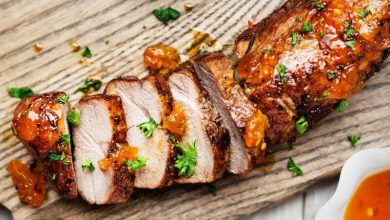🥗 Antipasto Salad 🥗
Antipasto salad is a delicious and colorful Italian salad known for its rich flavors and variety of ingredients. It’s a popular appetizer or side dish in Italian cuisine, and it’s perfect for those who enjoy a combination of savory, salty, and tangy flavors. Here’s everything you need to know about antipasto salad:
📜 History:
The term “antipasto” in Italian means “before the meal.” Antipasto dishes have been part of Italian dining culture for centuries, traditionally served before the main course to stimulate the appetite. Antipasto salads, as we know them today, likely evolved from this tradition, combining various ingredients to create a flavorful and satisfying appetizer.
🍽️ Components:
Antipasto salad is incredibly versatile, and its components can vary, but it typically includes a combination of the following ingredients:
- Cured Meats: Common choices are salami, pepperoni, prosciutto, and capicola.
- Cheeses: Mozzarella, provolone, and Parmesan are often used.
- Olives: Green and black olives add a briny flavor.
- Pickled Vegetables: Artichoke hearts, roasted red peppers, and pepperoncini peppers are popular.
- Fresh Vegetables: Cherry tomatoes, cucumber slices, and red onion add freshness.
- Fresh Herbs: Basil, oregano, and parsley can enhance the flavor.
- Dressing: Typically, a simple vinaigrette with olive oil, balsamic vinegar, garlic, and Italian herbs is used.
👩🍳 Preparation:
Here are the steps to prepare a delicious antipasto salad:
- Gather Ingredients: Assemble all the ingredients mentioned above.
- Prepare Meats and Cheeses: Slice the cured meats and cheeses into bite-sized pieces.
- Cut and Arrange Vegetables: Cut the fresh vegetables into bite-sized pieces or slices. Drain any pickled vegetables.
- Combine Ingredients: In a large salad bowl, combine the meats, cheeses, olives, pickled vegetables, and fresh vegetables.
- Add Herbs: Sprinkle fresh herbs like basil, oregano, and parsley over the salad.
- Make Dressing: In a separate bowl, whisk together olive oil, balsamic vinegar, minced garlic, and Italian herbs. Adjust the ingredients to taste.
- Dress the Salad: Drizzle the dressing over the salad and toss gently to coat all the ingredients evenly.
- Chill and Serve: Allow the salad to chill in the refrigerator for at least 30 minutes before serving. This helps the flavors meld together.
- Serve: Serve your antipasto salad as an appetizer or side dish. It’s great with crusty Italian bread.
⏱️ Preparation Time:
The preparation time for antipasto salad can vary depending on how much chopping and slicing is involved. On average, it takes about 20-30 minutes to prepare the ingredients and another 30 minutes to chill in the refrigerator. So, you can typically have this delicious salad ready to enjoy in about 50-60 minutes.
🍽️ Whether you’re serving it at a gathering or as a light meal, antipasto salad is a delightful dish that’s sure to please your taste buds with its harmonious blend of flavors and textures. Buon appetito! 🇮🇹🥗😋
Certainly, here are the nutrition facts and some health information for Antipasto Salad:
📊 Nutrition Facts (Approximate, per serving):
- Calories: 300-400 calories
- Total Fat: 20-30 grams
- Saturated Fat: 7-10 grams
- Cholesterol: 30-50 mg
- Sodium: 800-1000 mg
- Total Carbohydrates: 10-15 grams
- Dietary Fiber: 2-4 grams
- Sugars: 3-5 grams
- Protein: 15-20 grams
🌿 Health Information:
-
Rich in Protein: Antipasto salad contains a good amount of protein, primarily from the cured meats and cheeses. Protein is essential for muscle repair and overall health.
-
Healthy Fats: While it has some fats, many of them come from heart-healthy sources like olive oil, which is rich in monounsaturated fats.
-
Sodium Content: Be mindful of the sodium content, especially if you have high blood pressure or are watching your sodium intake. Olives, cured meats, and pickled vegetables can be high in salt.
-
Fiber: The salad contains some dietary fiber from the vegetables and olives, which is beneficial for digestive health.
-
Vitamins and Minerals: Antipasto salad is a good source of various vitamins and minerals, including vitamin C (from peppers and tomatoes), calcium (from cheese), and iron (from cured meats).
-
Caloric Intake: The calorie content can vary depending on portion size and ingredient choices. If you’re watching your calorie intake, be mindful of portion sizes and the amount of dressing used.
-
Balanced Meal: While it’s a flavorful and satisfying salad, it’s essential to balance it with other components of your meal to ensure you’re getting a wide range of nutrients.
-
Customization: You can make this salad healthier by choosing leaner meats, reducing cheese, and using a lighter dressing. Additionally, adding more fresh vegetables can increase its nutritional value.
Remember that the specific nutritional content can vary based on the ingredients you use and portion sizes. It’s always a good practice to check labels and adjust the recipe to meet your dietary preferences and needs.




